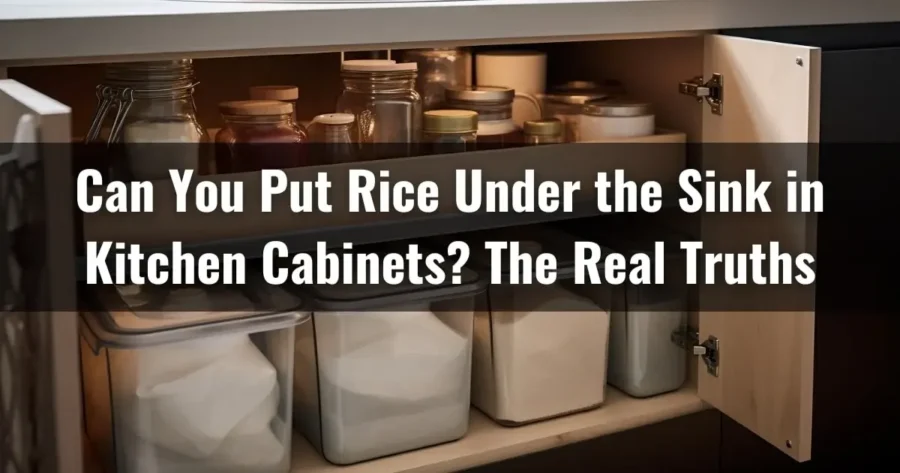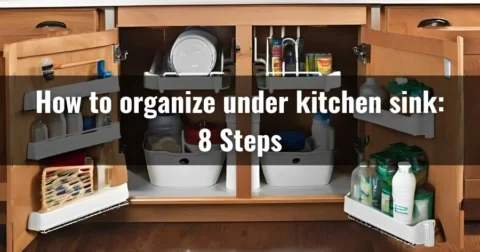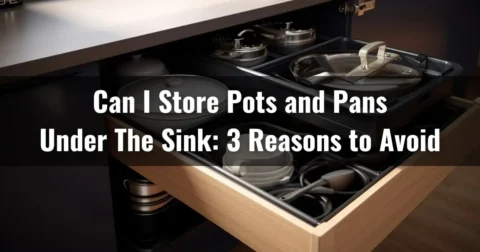Storing rice under the sink in our kitchen cabinets may seem good to some of us. While it may seem convenient, storing rice under the sink in kitchen cabinets for a long time can lead to spoilage due to the moisture and humidity.
Rice is highly susceptible to moisture, and a small amount can cause clumping and mold growth. So you should only put rice under the kitchen sink cabinets in an emergency. In this instance, the rice should only be stored in an airtight container for a short period, typically three to five days.
Today, we will explore some items you should not store in your under-sink kitchen cabinets. So, continue reading to gain a deeper understanding.
Jump to Section
What Other Things You Should Avoid Putting Under Sink Cabinets in Your Kitchen Besides Rice?

When storing items under your kitchen sink cabinets, you should avoid a few things. These includes:
Let’s take a look at why you shouldn’t store these items under the kitchen sink:
1. Food Items
Storing rice or any other food in a drawer under the sink can expose it to moisture and humidity, leading to spoilage and potential contamination. Moisture can affect the quality of rice and other food items by causing it to become damp and sticky, making it more susceptible to mold growth.
Also, pests such as ants or cockroaches are attracted to areas with high moisture content, which can further contaminate your food supplies. Instead of keeping food items under the sink, storing them in a dry pantry or cabinet is best to prevent moisture-related issues.
2. Non-Waterproof Containers
Avoid storing items in non-waterproof containers as leaks or spills can easily damage them, leading to a messy and unsanitary situation. These containers, such as cardboard boxes or porous containers, are unsuitable for this storage.
Any leakage or spillage from the container can seep into the rice and make it soggy or even contaminate it with bacteria.
To ensure the freshness and safety of your rice, opt for waterproof containers like plastic bins or glass jars with tight-fitting lids. These will protect your rice from potential water damage and help maintain its quality for longer.
3. Paper Products
Paper, like napkins and paper plates, is highly susceptible to water damage and can easily lose its integrity when exposed to moisture. Therefore, keep these items from leaks, such as under the sink kitchen cabinets.
Instead, consider storing them in a well-ventilated pantry or cupboard free from any moisture-prone areas. This will ensure that your paper products remain in good condition when needed. Also, be mindful of any signs of pipe leakage and address them promptly to avoid any potential damage to your stored items.
4. Wooden Items
Wooden utensils, cutting boards, or kitchen tools can warp or become damaged when exposed to moisture over time, so keeping them in a dry area is important.
Storing these items under the sink kitchen cabinets may not be the best idea as it can expose them to water leaks or spills. Moisture from sinks and pipes could seep into the cabinets and affect the wooden items.
Instead, consider finding a designated spot in your kitchen to store your wooden utensils and cutting boards safely. A dry countertop or a cabinet away from water sources would be ideal.
5. Electrical Appliances
Storing appliances like blenders, toasters, or coffee makers under the sink can pose safety and functional risks due to potential exposure to water or excess moisture. If water leaks occur, be mindful that electrical appliances under the sink may get damaged.
Water leaks can cause irreversible damage to these appliances, leading to electrical malfunctions and potential hazards. To ensure the longevity of your electrical appliances and maintain a safe kitchen environment, store them in dry areas away from any potential water sources.
6. Potentially Harmful Chemicals
Prioritize safety when storing potentially harmful chemicals in your home. Strong chemicals should not be stored under the sink due to potential risks, even if the area is child-proofed.
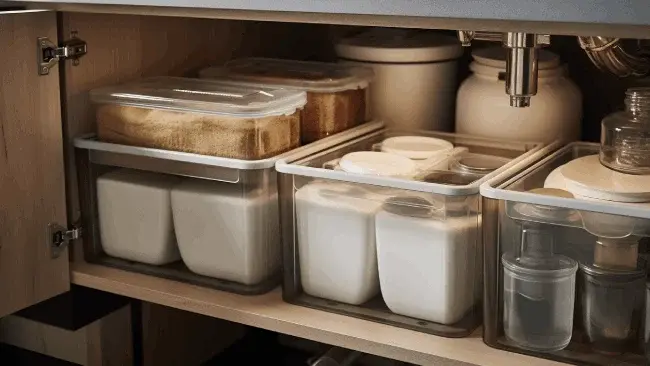
The space under the sink may seem convenient, but it can pose a threat, especially if you have children or pets. Strong chemicals like bleach, cleaning solvents, and pesticides should be stored more securely.
Consider placing them on a higher shelf out of reach or storing them in a locked cabinet. Alternatively, you could store these items in your basement or garage, where they are less accessible to curious hands.
7. Open Dish Soap and Dishwasher Detergent
Leaving dish soap and dishwasher detergent open can lead to moisture getting in, affecting their effectiveness over time. Also, in case of spills or leaks from these containers, they could create a mess or damage other nearby items.
To avoid any issues, tightly close the lids of your dish soap and dishwasher detergent bottles before storing them under the sink.
8. Medications
Storing medications under the sink is not recommended as it exposes them to moisture and potential temperature changes. Instead, find a secure spot in your home that meets these criteria.
A dedicated storage box or medicine cabinet can be ideal choices. Also, check the expiration dates regularly and dispose of any medications that have passed their expiration date.
9. Flammable Items
Ensure there aren’t any flammable items stored under the sink cabinets, as this can be a potential hazard due to the presence of any heat source. Certain items like paint thinner, varnishes or specific cleaning products can easily catch fire if exposed to heat or sparks.
The under-sink area is often cramped and may have electrical wiring running through it, making it unsafe for storing flammable materials. To ensure your kitchen cabinets remain safe, designate a separate storage space for these items away from potential ignition sources.
10. Items That Can Get Wet
Remember that certain items, like paper documents or wooden utensils, should not be stored under the sink as they can easily get damaged if they come into contact with water.
FAQ’s: Can You Put Rice Under the Sink
Can pests be a problem when storing rice under the kitchen sink cabinet?
Storing rice under the kitchen sink cabinets can attract pests like ants, roaches, or rodents. These critters are always looking for food sources, and leaving rice exposed in this area makes it an easy target.
To keep pests away, it is essential to store your rice properly. Invest in airtight containers with secure lids that prevent any access points for these unwanted visitors. Transfer the rice from its original packaging into these containers immediately.
Also, regularly clean and check for any signs of pests in and around the cabinet area. By taking these precautions, you can ensure that your stored rice remains pest-free and safe for consumption.
What’s the best way to store rice for long-term freshness?
Store your rice in an airtight container in a cool, dry, dark pantry or cupboard to maintain long-term freshness. This helps to protect the rice from moisture and pests that can cause spoilage. An airtight container ensures no air gets in or out, preventing contamination.
A cool and dry environment is ideal because humidity can lead to the growth of mold or bacteria on the rice. It’s also essential to keep the rice away from direct sunlight as exposure to light can degrade its quality over time.
What are the signs that rice has gone bad after storing it in the kitchen sink cabinet?
If the rice in the kitchen sink cabinet has gone bad, you may notice a strange odor, off-color, or unusual texture. Expired rice can develop a slimy or gooey consistency. Pay attention to these signs as they indicate that the rice is no longer safe for consumption.
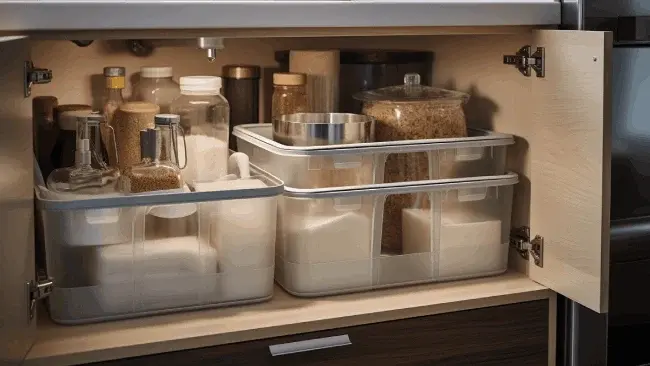
When stored improperly, such as in a kitchen sink cabinet, rice can be exposed to moisture and fluctuating temperatures, accelerating spoilage. Storing rice in a cool, dry place like a pantry or cupboard with a tight-sealing lid is best to ensure long-term freshness.
Conclusion
It is never a good idea to store rice under the sink in kitchen cabinets to save space, as moisture and humidity will spoil the grain. To prevent contamination and damage from leaks or spills, you must make sure other items are not stored in this area at the same time as rice.
Follow proper storage techniques, like using sealed containers or bags, to ensure long-term freshness and avoid unpleasant surprises when cooking your grains.
By considering where you store your essential items, you can prolong their lifespan and ensure they are safe to use. So, store your rice and other kitchen items in dry, secure locations to maintain their quality and avoid unpleasant surprises.


